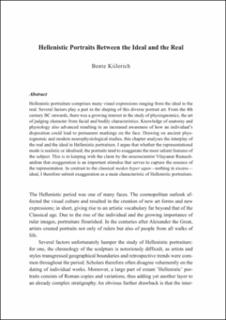Hellenistic Portraits between the Ideal and the Real
Journal article, Peer reviewed
Published version

Åpne
Permanent lenke
https://hdl.handle.net/11250/2988647Utgivelsesdato
2021Metadata
Vis full innførselSamlinger
Originalversjon
Papers and Monographs from the Norwegian Institute at Athens. 2021, 11, 15-46.Sammendrag
Hellenistic portraiture comprises many visual expressions ranging from the ideal to the real. Several factors play a part in the shaping of this diverse portrait art. From the 4th century BC onwards, there was a growing interest in the study of physiognomics, the art of judging character from facial and bodily characteristics. Knowledge of anatomy and physiology also advanced resulting in an increased awareness of how an individual’s disposition could lead to permanent markings on the face. Drawing on ancient physiognomic and modern neurophysiological studies, this chapter analyses the interplay of the real and the ideal in Hellenistic portraiture. I argue that whether the representational mode is realistic or idealised, the portraits tend to exaggerate the most salient features of the subject. This is in keeping with the claim by the neuroscientist Vilayanur Ramachandran that exaggeration is an important stimulus that serves to capture the essence of the representation. In contrast to the classical meden hyper agan—nothing in excess— ideal, I therefore submit exaggeration as a main characteristic of Hellenistic portraiture.